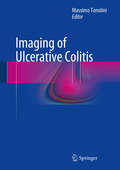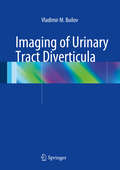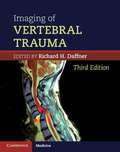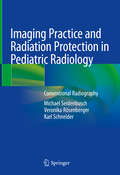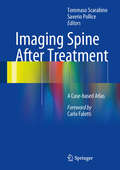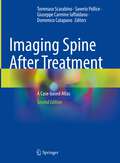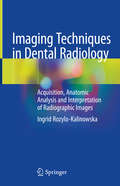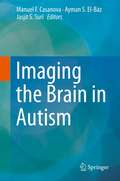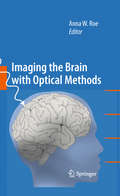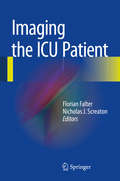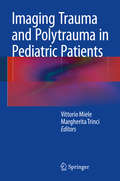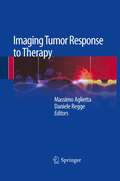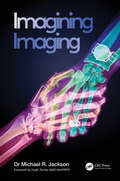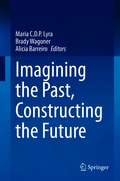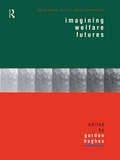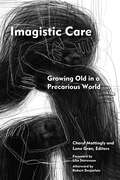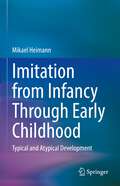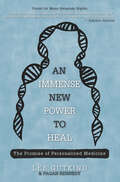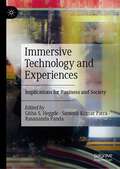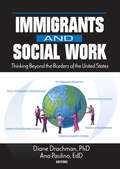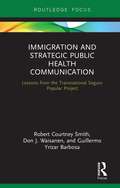- Table View
- List View
Imaging of Ulcerative Colitis
by Massimo TonoliniDuring the past decade, the medical and surgical treatment of ulcerative colitis has undergone dramatic advances, including the widespread use of immunomodulators, biological drugs, and restorative proctocolectomy. In order to correctly balance the risks and benefits of medical therapies and surgical procedures, there is a need for improved diagnosis of colonic disease, acute complications, extraintestinal manifestations, and early and delayed postoperative complications. Cross-sectional imaging techniques are therefore playing an increasing role in the assessment of ulcerative colitis and provide an essential complement to clinical data and endoscopy. This practical, illustrated volume on the role of cross-sectional imaging is aimed at radiologists, gastroenterologists, and surgeons who are engaged or interested in the diagnosis and care of patients with inflammatory bowel disease, particularly ulcerative colitis. After an overview of diagnostic imaging techniques, state-of-the-art assessment of colorectal inflammatory disease with CT colonography using water enema is discussed, followed by description of the plain radiographic and CT findings in patients with acute exacerbations and surgical complications. Subsequent chapters review the diagnostic findings and role of cross-sectional imaging in the assessment of sclerosing cholangitis (with emphasis on MR cholangiopancreatography), vascular complications (particularly portal and mesenteric thrombosis), associated neoplasms, such as colorectal cancer and abdominal desmoids, and perianal inflammatory disease. Normal postoperative appearances and early and delayed complications in patients treated with proctocolectomy and ileal pouch-anal anastomosis are also comprehensively reviewed.
Imaging of Urinary Tract Diverticula
by Vladimir M. BuilovThis monograph covers all aspects of the radiologic diagnosis of urinary tract diverticula, including calyceal, ureteral, bladder and urethral diverticula. Characteristic and subtle diagnostic features are identified with the aid of numerous high-quality ultrasound, X-ray and magnetic resonance images, the vast majority of which are drawn from the author's personal clinical practice. In addition, issues relating to terminology, classification, statistics, etiology, pathogenesis, clinical presentation and differential diagnosis are discussed. The text is complemented by two helpful appendices that document the latest recommendations of the European Society of Urogenital Radiology regarding use of contrast media and the European Medicines Agency on minimizing the risk of nephrogenic systemic fibrosis when using gadolinium-containing contrast agents. This book will be of value for specialists in radiology and urology and also trainees and medical students.
Imaging of Vertebral Trauma
by Richard H. DaffnerThe imaging methods used to evaluate patients with suspected vertebral injuries have undergone radical changes in the past decade, the most significant being the ascendancy of computed tomography (CT) to become the primary investigative modality. Issues such as high radiation dose associated with CT studies and health care reform and cost containment also have a significant impact on clinical decision-making. This new edition of the classic landmark text for vertebral trauma imaging provides an in-depth discussion on the indications and methods of imaging the spine based on currently available clinical evidence. Every chapter has been extensively revised and the illustrations represent state-of-the-art imaging. A completely new chapter on pediatric injuries has been added. Imaging of Vertebral Trauma, third edition, is an invaluable and essential tool in the assessment of any patient with suspected vertebral or spinal cord injury.
Imaging of Vertebral Trauma (3rd Edition)
by Richard H. DaffnerThe imaging methods used to evaluate patients with suspected vertebral injuries have undergone radical changes in the past decade, the most significant being the ascendancy of computed tomography (CT) to become the primary investigative modality. Issues such as high radiation dose associated with CT studies and health care reform and cost containment also have a significant impact on clinical decision-making. This new edition of the classic landmark text for vertebral trauma imaging provides an in-depth discussion on the indications and methods of imaging the spine based on currently available clinical evidence. Every chapter has been extensively revised and the illustrations represent state-of-the-art imaging. A completely new chapter on pediatric injuries has been added. Imaging of Vertebral Trauma, third edition, is an invaluable and essential tool in the assessment of any patient with suspected vertebral or spinal cord injury.
Imaging Practice and Radiation Protection in Pediatric Radiology: Conventional Radiography
by Michael Seidenbusch Veronika Rösenberger Karl SchneiderThis book offers the reader sound advice on how to perform optimal conventional pediatric radiographs and how to obtain quick and easy organ dose estimates in order to improve the optimization process in pediatric imaging. Clear guidelines are provided for minimization of the radiation exposure of children through optimization of the radiation exposure conditions, and conversion coefficients are presented for calculation of the organ doses achieved in organs and tissues during conventional pediatric radiography, taking into consideration both optimal and suboptimal radiation field settings. Previously published conversion coefficients have failed to represent the variation in radiation field settings in daily clinical routine, which has made it difficult for the pediatric radiologist to estimate the impact of the field settings on absorbed doses in organs and tissues. The aim of this book, co-written by a pediatric radiologist, a physician and physicist, and a medical radiation technologist, is to address this issue by providing, for the first time, a thorough overview of clinical radiation field settings and their implications for radiation protection. An accompanying volume is devoted to fluoroscopy.
Imaging Spine After Treatment
by Tommaso Scarabino Saverio PolliceThis book reviews in detail the role of neuroradiological imaging in the evaluation of patients who have undergone surgery or interventional radiology procedures, and particularly its value in the documentation of normal and pathological post-treatment changes, detection of complications, and follow-up. The opening sections describe pretreatment images in various conditions, including trauma, degenerative disc disease, and osteoporosis, and the different types of neurosurgical and interventional treatment that may be used. The post-treatment appearances of normal sequelae and complications on conventional radiography, CT, and MRI are then documented in detail on the basis of a large series of clinical cases, with a wealth of images. Guidance is provided on selection of one or a combination of imaging modalities. This book will be an invaluable clinical and research tool not only for neuroradiologists but also for neurosurgeons, and interventional radiologists.
Imaging Spine After Treatment: A Case-based Atlas
by Tommaso Scarabino Saverio Pollice Giuseppe Carmine Iaffaldano Domenico CatapanoThis atlas illustrates the characteristics of imaging after surgical spine treatment. The previous edition has been thoroughly updated and new surgical treatment options are presented. Furthermore, all clinical cases feature new images with the new sequences available from the manufacturers of Magnetic Resonance scanners. The imaging methods presented in the book are MRI, involving the use of routine basic sequences and advanced study techniques, and CT with and without administration of contrast medium. The modifications of the spine, both healthy and pathological, that can occur immediately after surgical treatment and in the long term, are described in detail. Atlas contents are organized in a general part, with the classification of spine pathology and the surgical treatment options, and a part with clinical cases enriched by a wealth of images. This easy-to-consult publication addresses neuroradiologists who wish to gain an adequate expertise in post-treatment examinations reporting in order to be able to perform an effective differential diagnosis.
Imaging Techniques in Dental Radiology: Acquisition, Anatomic Analysis and Interpretation of Radiographic Images
by Ingrid Rozylo-KalinowskaThis book is an up-to-date guide to the performance and interpretation of imaging studies in dental radiology. After opening discussion of the choice of X-ray equipment and materials, intraoral radiography, panoramic radiography, cephalometric radiology, and cone-beam computed tomography are discussed in turn. With the aid of many illustrated examples, patient preparation and positioning are thoroughly described for each modality. Common technical errors and artifacts are identified and the means of avoiding them, explained. The aim is to equip the reader with all the information required in order to perform imaging effectively and safely. The normal radiographic anatomy and landmarks are then discussed, prior to thorough coverage of frequent dentomaxillofacial lesions. Accompanying images display the characteristic features of each lesion. Further topics to be addressed are safety precautions for patients and staff. The book will be an ideal aid for all dental practitioners and will also be of value for dental students.
Imaging the Brain in Autism
by Jasjit S. Suri Ayman S. El-Baz Manuel F. CasanovaData compiled by the Center for Disease Control and Prevention indicates an alarming and continuing increase in the prevalence of autism. Despite intensive research during the last few decades, autism remains a behavioral defined syndrome wherein diagnostic criteria lack in construct validity. And, contrary to other conditions like diabetes and hypertension, there are no biomarkers for autism. However, new imaging methods are changing the way we think about autism, bringing us closer to a falsifiable definition for the condition, identifying affected individuals earlier in life, and recognizing different subtypes of autism. The imaging modalities discussed in this book emphasize the power of new technology to uncover important clues about the condition with the hope of developing effective interventions. Imaging the Brain in Autism was created to examine autism from a unique perspective that would emphasize results from different imaging technologies. These techniques show brain abnormalities in a significant percentage of patients, abnormalities that translate into aberrant functioning and significant clinical symptomatology. It is our hope that this newfound understanding will make the field work collaborative and provide a path that minimizes technical impediments.
Imaging the Brain with Optical Methods
by Anna W. RoeThe technology of detecting and interpreting patterns of reflected light has reached a remarkable degree of maturity that now permits high spatial and temporal resolution visualization at both the systems and cellular levels. There now exist several optical imaging methodologies, based on either hemodynamic changes in nervous tissue or neurally-induced light scattering changes, that can be used to measure ongoing activity in the brain. In two parts, Imaging the Brain with Optical Methods discusses the history of optical imaging and its use in the study of brain function, and the rapidly developing optical technologies and their applications that have recently developed. These include intrinsic signal optical imaging, near-infrared optical imaging, fast optical imaging based on scattered light, optical imaging with voltage sensitive dyes, and 2 photon imaging of hemodynamic signals. In total, this volume will encapsulate the current state of optical imaging methodologies and their contribution towards understanding the spatial and temporal organization of cerebral cortical function.
Imaging the ICU Patient
by Florian Falter Nicholas J. ScreatonThe critical care unit is an intense clinical environment with huge responsibilities on the professionals caring for these patients. Imaging is a key source of diagnostic information, but the conditions in which diagnostic imaging has to be performed are often extremely challenging and significantly different to imaging in the non acute setting. Imaging the ICU Patient reviews imaging procedures on the ICU in a highly practical and memorable manner. Swift and efficient clinical decision-making is rewarded on the ICU and this book serves as a practical handbook.
Imaging Trauma and Polytrauma in Pediatric Patients
by Vittorio Miele Margherita TrinciThis book provides a detailed and comprehensive overview of the role of diagnostic imaging in the assessment and management of trauma and polytrauma in children. The coverage includes imaging of injuries to the head, thorax, abdomen, bone and musculoskeletal system, with careful attention to the newest imaging techniques, imaging during the course of recovery and imaging of complications. A series of illustrative cases underline the prognostic value of imaging. In addition, an individual chapter is devoted to diagnostic imaging in cases of child abuse. The book concludes by discussing informed consent and medicolegal issues related to the imaging of pediatric traumatic emergencies. Imaging Trauma and Polytrauma in Pediatric Patients will be invaluable in enabling radiologists and clinicians to identify the main features and signs of injuries on a wide range of imaging techniques, including X-ray, ultrasonography, computed tomography and magnetic resonance imaging.
Imaging Trauma and Polytrauma in Pediatric Patients
by Vittorio Miele and Margherita TrinciThis book provides a detailed and comprehensive overview of the role of diagnostic imaging in the assessment and management of trauma and polytrauma in children. The coverage includes imaging of injuries to the head, thorax, abdomen, bone and musculoskeletal system, with careful attention to the newest imaging techniques, imaging during the course of recovery and imaging of complications. A series of illustrative cases underline the prognostic value of imaging. In addition, an individual chapter is devoted to diagnostic imaging in cases of child abuse. The book concludes by discussing informed consent and medicolegal issues related to the imaging of pediatric traumatic emergencies. Imaging Trauma and Polytrauma in Pediatric Patients will be invaluable in enabling radiologists and clinicians to identify the main features and signs of injuries on a wide range of imaging techniques, including X-ray, ultrasonography, computed tomography and magnetic resonance imaging.
Imaging Tumor Response to Therapy
by Daniele Regge Massimo AgliettaMeasurement of solid tumor response to treatment relies mainly on imaging. WHO tumor response criteria and, more recently, RECIST (response evaluation criteria in solid tumors) have provided means to objectively measure tumor response in clinical trials with imaging. These guidelines have been rapidly adopted in clinical practice to monitor patient treatment and for therapy planning. However, relying only on anatomical information is not always sufficient when evaluating new drugs that will reduce a tumor's functionality while preserving its size. Finding more reliable and reproducible measures of tumor response is one of the most important and difficult challenges facing modern radiology as it requires an entirely new approach to imaging. The aim of this book is to address the assessment of response to treatment by adopting a multidisciplinary perspective, just as occurs in real life in a comprehensive cancer center. Oncologists and imaging experts consider two cancer models, locally advanced disease and metastatic disease, jointly exploring both conventional and advanced means of measuring response to standard treatment protocols and new targeted therapies.
Imagining Imaging
by Michael R. JacksonFrom Roentgen to Rembrandt, Hounsfield to Hollywood and Vesalius to videogames, Imagining Imaging explores the deeply entwined relationship between art (and visual-based culture) and radiology / medical imaging. Including artworks from numerous historical eras representing varied geographic locations and visual traditions, alongside a diverse range of contemporary artists, Dr Jackson argues that the foundations of medical image construction and interpretation were laid down in artistic innovations dating back hundreds and thousands of years. Since the discovery of X-rays, artists and moviemakers have, in turn, drawn rich inspiration from radiographic imagery and concepts, but the process of cross-pollination between art and science has continued, with creative endeavour continuing to mould medical imaging examinations to this day.Blending a unique mix of art, science and medical history, together with aspects of visual neurophysiology and psychology, Imagining Imaging is essential reading for radiologists, radiographers and artists alike. Peppered with familiar TV and film references, personal insights into the business of image interpretation, and delivered in an accessible and humorous style, the book will also appeal to anyone who enjoys looking at pictures.Key features: Engaging synthesis of art and medical history, combined with anecdotes and experiences from a working clinical radiologist Diverse range of visual reference points including astronomy, botany and cartography, alongside comprehensive discussion of medical imaging modalities including plain radiography, ultrasound, CT and MRI 200 full colour illustrations
Imagining the Past, Constructing the Future
by Maria C. D. P. Lyra Brady Wagoner Alicia BarreiroThis book takes a sociocultural, developmental and dialogical perspective to explore the constructive and interconnected nature of remembering and imagining. Conceived as cognitive-affective processes, both emerge at the border of the person and his or her socio-cultural world. Memory is approached as a functional adaption to the environment using the resources of the past in preparation for action in the present. Imagination is tightly related to memory in that both aim to escape the confines of the concrete here-and-now situation; however, while memory is primarily oriented to the past, imagination looks to the future. Both are embedded in the exchanges with the social and cultural milieu, and thus theorizing them has relied on key ideas from Lev Vygotsky, Frederic Bartlett and Mikhail Bakhtin. Thus, this book aims to integrate theories of remembering and imagining, through rich empirical studies in diverse cultural settings and concerning the development of self and identity. These two groups of studies compose the subparts that organize the book.
Imagining Welfare Futures (Social Policy: Welfare, Power and Diversity)
by Gordon HughesImagining Welfare Futures explores possible futures of welfare by considering different types of relationship between the public and the state through which social welfare may be organized beyond the millennium. By drawing on contemporary debates about the 'citizen', 'the community' and 'the consumer', the book explores what each of these imaginary figures might mean for the next generation of welfare users.
Imagistic Care: Growing Old in a Precarious World (Thinking from Elsewhere)
by Robert Desjarlais Rasmus Dyring Harmandeep Kaur Gill Lone Grøn Maria Louw Cheryl Mattingly Lotte Meinert Maria Speyer Helle Sofie Wentzer Susan Reynolds WhyteImagistic Care explores ethnographically how images function in our concepts, our writing, our fieldwork, and our lives. With contributions from anthropologists, philosophers and an artist, the volume asks: How can imagistic inquiries help us understand the complex entanglements of self and other, dependence and independency, frailty and charisma, notions of good and bad aging, and norms and practices of care in old age? And how can imagistic inquiries offer grounds for critique? Cutting between ethnography, phenomenology and art, this volume offers a powerful contribution to understandings of growing old. The images created in words and drawings are used to complicate rather than simplify the world. The contributors advance an understanding of care, and of aging itself, marked by alterity, spectral presences and uncertainty.Contributors: Rasmus Dyring, Harmandeep Kaur Gill, Lone Grøn, Maria Louw, Cheryl Mattingly, Lotte Meinert, Maria Speyer, Helle S. Wentzer, Susan Reynolds Whyte
Imitation from Infancy Through Early Childhood: Typical and Atypical Development
by Mikael HeimannThis book summarizes more than four decades of research on imitation in infancy and its relation to early learning and sociocognitive development in typically and atypically developing children. The studies were carried out in a Scandinavian context and thus provide important cultural validation of the central developmental processes. The book is divided into three parts: Part one focuses on the social and cognitive aspects of imitation, discussing links to early parent-infant interaction, and developmental meaning. It addresses evidence for an imitative capacity at birth for typical and atypical infants. Also covered are early individual differences in imitation, the role of imitation as a social and cognitive learning mechanism in early development, and possible links between imitation and temperament. Part two presents unique longitudinal studies on early memory development using deferred imitation as the key method. It discusses the biological basis of memory and explores the idea that deferred imitation is an indicator of an infant’s ability to understand intentions. Part three focuses on imitation in young children with autism and with Down syndrome. It examines the role of imitation as a “deficit” as well as a vehicle for change when used interactively in early interventions for children with autism. Imitation from Infancy Through Early Childhood is an essential resource for researchers, professors, and graduate students as well as clinicians and other professionals in developmental psychology, cognitive development, psycholinguistics, child psychiatry, and developmental neuroscience.
Immaculate Forms: Uncovering the History of Women's Bodies
by Helen KingThroughout history, religious scholars, medical men and - occasionally - women themselves, have moulded thought on what 'makes' a woman. She has been called the weaker sex, the fairer sex, the purer sex, among many other monikers. Often, she has been defined simply as 'Not A Man'.Today, we are more aware than ever of the complex relationship between our bodies and our identities. But contrary to what some may believe, what makes a woman is a question that has always been open-ended.Immaculate Forms examines all the ways in which medicine and religion have played a gatekeeping role over women's organs. It explores how the womb was seen as both the most miraculous organ in the body and as a sewer; uncovers breasts' legacies as maternal or sexual organs - or both; probes the mystery of the disappearing hymen, and asks, did the clitoris need to be discovered at all?
An Immense New Power to Heal
by Lee Gutkind Pagan KennedyIs personalized medicine--what some scientists call genetic medicine--a pipe dream or a panacea? Francis Collins, current director of the National Institutes of Health and director of the Human Genome Project, considers this new era "the greatest revolution since Leonardo," while Nobel Laureate Leland Hartwell compares personalized medicine to a train that has not yet left the station--"a very slow train with a very long way to go . . . before we arrive at our destination."There is no denying that new technology, which has triggered an explosion of scientific information, is ushering in a revolution in medicine--for specialists, general practitioners and the public. Anyone can spit in a cup and, for a small fee, learn about his or her individual genetic make-up. But how useful is this information, really, to us or to our doctors? What's more, how much do we truly want to know--and have others know--about our possible destiny? There is more than we can imagine at stake.In An Immense New Power to Heal, authors Lee Gutkind and Pagan Kennedy delve into the personal side of personalized medicine and offer the physician's perspective and the patient's experience through intimate narratives and case studies. They also offer an intriguing background of the personalized medicine movement including the fascinating personalities of the key scientists involved as well as a glimpse into the in-fighting that accompanies any race for a scientific breakthrough. The result is a highly engaging, lively, and provocative discussion about this revolution in health care, and most importantly, what it really means for patients now and in the future.
Immersive Technology and Experiences: Implications for Business and Society
by Githa S. Heggde Santosh Kumar Patra Rasananda PandaThis book provides a comprehensive overview of the role of immersive technology with multiple sectoral perspectives, such as entertainment, education, health care, and more. It covers a detailed analysis of the latest trends and developments in the field. It encompasses practical insights on using immersive technology effectively through industry expert chapters, case studies, and real-world examples that demonstrate how immersive technology is being used in different industries. Chapters in this book are from academicians and industry professionals to create a fine balance of knowledge and practice perspective of today’s immersive technology. It is written in accessible language that is easy for non-experts to understand. It focuses on the future of immersive technology, exploring its potential impact on society and the economy. It provides insights into the challenges and opportunities that lie ahead and offers predictions on how immersive technology will continue to evolve in the years to come. It is a valuable resource for anyone learning more about immersive technology.
Immigrants and Social Work: Thinking Beyond the Borders of the United States
by Diane Drachman Ana PaulinoExplore an understudied but vital aspect of the immigration experience!Until now, the American social work literature on immigration has emphasized one part of the migration process-the experiences of immigrants in this country. Country-of-origin experiences that lead to emigration have received limited attention. Immigrants and Social Work: Thinking Beyond the Borders of the United States expands the focus of the literature, drawing clear connections between immigrants&’ situations in their countries of origin and how they adapt to their new country.This book presents a two (or more)country perspective on immigration, looking at migration as a process that requires an understanding of phenomena that occur in immigrants&’ country of origin and that impact their lives in the United States. It also looks at immigrants&’ back-and-forth movements between their home and new countries, and examines the immigration process when it involves movement to a third or fourth country-or, as in the case of the Armenian diaspora, a return to the home country after years of settlement in a new land.To provide immigrants with effective social services, it is essential to understand the situations that prompted them to uproot their lives and start over in a new country. Immigrants and Social Work: Thinking Beyond the Borders of the United States provides an unflinching look at many of these country-of-origin issues, examining: mental health issues that result from the traumatic experiences of undocumented Mexican immigrants the essential link between international social work and social work with immigrants and refugees in the United States cross-national collaboration between educators in the United States and Armenia that is helping to provide vital services to Armenian refugees the phenomenon of return migration the migration experiences of women living in towns along the United States/Mexico border culturally competent mental health service delivery for Chinese immigrants circular migration between Puerto Rico and the United States the challenges facing impoverished Dominican immigrants to the United States-and a look at the relationship between the two countries&’ policies regarding migrationImmigrants and Social Work: Thinking Beyond the Borders of the United States is important reading for social work professionals who serve immigrant populations. It is also an ideal ancillary text for courses in international social work, family policy, social work with immigrants and refugees, child welfare, and social work practice with families, as well as any social work course that covers Chinese, Mexican, Armenian, Puerto Rican, or Dominican immigrant populations. Make it a part of your teaching/professional collection today.
Immigration and Strategic Public Health Communication: Lessons from the Transnational Seguro Popular Project (Routledge Research in Health Communication)
by Robert Smith Don Waisanen Guillermo Yrizar BarbosaThis book engages a key question facing governments and similar institutions in countries of immigration or emigration: how should these governments and institutions communicate with immigrants so that they will listen to and act on their messages? Drawing on original research with Mexican emigrants in New York and the Mexican government’s Seguro Popular health care program, the authors examine the ways in which governments integrate migrants into diasporic political, medical, educational, and other systems, and how migrant-sending countries communicate with their emigrants abroad. In analyzing how these efforts fail or succeed, this book presents strategies and policy recommendations that many governments and institutions can use to engage their citizens or clients ethically and effectively. Offering a valuable approach to the study of race, migration, and public policy, this book will be of key importance to researchers and graduate students in public health, sociology, marketing and business, political science, Latinx studies, and international communication.
Immigration Policy and Immigrant Families (National Symposium on Family Issues #NA)
by Jennifer Van Hook Valarie KingThis book examines how immigration law impacts U.S. immigrant families. It addresses how admission and border policies shape family formation and contribute to prolonged family separation; how immigration enforcement affects parenting practices; and how immigrants’ unique challenges spill over to influence broader kinship support networks. Chapters describe family reunification and separation policies; return migration and binational family life; how young immigrants reconnect with family abroad and navigate romantic relationships in the United States; parents’ engagement with surveilling actors and institutions; the impact of immigration policy on parenting, including during the pandemic; the health and well-being of DACA (Deferred Action for Childhood Arrivals)-eligible adults and their children; aging and family dynamics among Asian immigrant families; and the impact of immigrant legal status across generations. Finally, the volume offers recommendations for family researchers on ways to advance our understanding of the short and longer-term effects of immigration law and policies on the formation, structure, and functioning of immigrant families. Key areas of coverage include: Immigrant laws and policies that shape the formation and separation of immigrant families. Immigrant parenting in the context of immigration enforcement. Effects of DACA and other immigrant policies on child and adult health and well-being. Long-term impacts of immigration policy over time and across generations. Opportunities for family research to better understand how immigration policies and practices shape families, parenting, and child health and well-being. Immigration Policy and Immigrant Families is a must-have resource for researchers, professors, and graduate students as well as clinicians, therapists, and other professionals in developmental psychology, family studies, sociology, and such interrelated disciplines as demography, social work, prevention science, public health, educational policy, political science, and economics.
